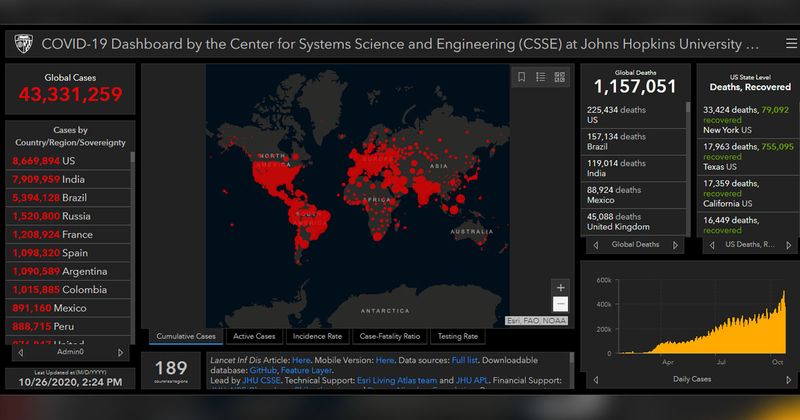Johns Hopkins COVID-19 dashboard provides ‘exhaustive information’ to clinicians
Click Here to Manage Email Alerts
Johns Hopkins University launched its popular COVID-19 map on Jan. 22 — just 2 days after the first person in the United States was diagnosed with the novel coronavirus.
Exactly 8 months later, Healio and others cited the university’s COVID-19 dashboard on Sept. 22 when reporting that the U.S. had surpassed 200,000 deaths from COVID-19.

Since its launch, the dashboard, which is part of the university’s coronavirus resource center, has become an essential resource for tracking the scope and scale of the pandemic — not just for media outlets but also for clinicians, said Infectious Disease News Editorial Board Member Gitanjali Pai, MD, AAHIVS.
The dashboard is also cited frequently by public health and government officials. It is run by more than two dozen people and funded by Johns Hopkins University, Bloomberg Philanthropies, the Stavros Niarchos Foundation and the National Science Foundation. It works by collecting confirmed reports and deaths from nearly 200 sources, including WHO and other international and local health agencies and state- and county-level reports in the U.S. It uses real-time mapping software provided by the company Esri.
“At first, the data were entered manually,” the Johns Hopkins media team told Healio. “Now, each source is vetted by the team of experts before an automated scraping program is deployed to collect the data on regular intervals. Other programs scan the data for any anomalies that are then investigated.”
According to a story by the Johns Hopkins online magazine, early on, Esri staffers compared the popularity of the coronavirus map to the company’s Pokémon Go map its most in-demand map at the time. By March, however, the volume of traffic to the COVID-19 dashboard had set the record as Esri’s highest used service of all time. Its use peaked in March, with 4.56 billion feature requests, according to the online story.

Pai, an infectious disease physician at Memorial Hospital and Physicians’ Clinic in Stilwell, Oklahoma, said there are many useful aspects of the resource center.
“Of course, the maps — with every useful parameter pertaining to COVID-19 cases — give exhaustive information to physicians, pharmacists, policymakers and other stakeholders,” she said. “The tracking and trends shown are comprehensive and user friendly. The commentary on the content of each page is insightful.”
The maps are some of the most widely used features of the dashboard. According to Johns Hopkins, the global map is the most up to date at any given time and is updated throughout the day. Any lags or delays in real-time data can be determined by checking the time of the most recent update in the lower left corner of the dashboard. The U.S. tracker is typically a day behind and also has a timestamp.
According to Pai, the resource center can be helpful in clinical practice because it helps disseminate data regarding new symptoms, new medications and new lines of treatment, which are “emerging almost every week.” She said the tables, pictographs and charts included in the resource center reveal trends and metrics that would otherwise be lost in the mass of information that has been publicized throughout the pandemic.
“This is particularly important in the light of a looming threat of a flare up in cases in the winter,” Pai said.
Moving forward, Pai said one way the dashboard could be improved is to add a daily tip on a new discovery or a significant development.
“Perhaps in the form of a flashing signal,” she said. “This will help alert the medical community and may also compel health care workers to visit it every day although a lot of us do visit it daily and often multiple times a day.”
Although many things remain uncertain about COVID-19, one thing observers can count on is that the Johns Hopkins COVID-19 dashboard will remain online for those seeking up-to-date information on the pandemic, according to those who run it.
“Given the popularity and impact of the dashboard to date, we plan to continue hosting and managing the tool throughout the entirety of the COVID-19 outbreak and to build out its capabilities to establish a standing tool to monitor and report on future outbreak,” Lauren Gardner, associate professor of civil and systems engineering and co-director of the Center for Systems Science and Engineering at Johns Hopkins University, and colleagues wrote in a Lancet Infectious Diseases paper. “We believe our efforts are crucial to help inform modeling efforts and control measures during the earliest stages of the outbreak.”
References:
Dong E, et al. Lancet Infect Dis. 2020;doi:10.1016/ S1473-3099(20)30120-1.
Harcourt J, et al. Emerg Infect Dis. 2020;doi.org/10.3201/eid2606.200516.
Healio Interviews
Johns Hopkins HUB. The unsung mapmakers. https://hub.jhu.edu/2020/10/05/unsung-mapmakers/. Accessed on Oct. 10, 2020.

